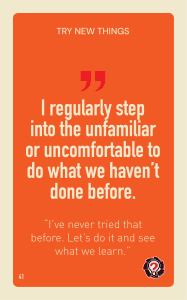Your leadership success depends on your skill at managing change and embracing the future
Are you hanging on to a familiar way of doing your work or leading your team because it’s comfortable? If it’s been a year or more since you experienced a significant change for yourself or your team, you might be missing out on great opportunities to build morale, build your career, and enjoy your work. Managing change is critical for your success—too much change, too quickly creates instability. But resisting natural, healthy change will prevent growth and stagnate your team.
Resisting Natural Change
Off the east coast of North Carolina and Virginia, a set of barrier islands known as the Outer Banks stretches over a couple hundred miles, guarding the inner sound from the worst of Atlantic storms. On a recent visit, our brother-in-law Steve, who’s visited these beaches and dunes for decades, took me on a driving tour and pointed out some changes he’s seen over the years.
He pointed across the road at a five-foot rise of sand you could walk across in a few steps. “To climb that dune, you used to have to work at it and scramble on all fours. It was huge.” We drove a little further and earth-moving equipment worked to keep blown sand from obliterating the narrow strip of asphalt road as the wind seemed to fight to reclaim and reshape the island.
Then he showed me the Oregon Inlet where private deep-sea fishing boats enter and leave the sound. “In the early 1800s the inlets all closed up and there weren’t’ any islands at all. It was a straight stretch of sand. Then, in 1846, a hurricane carved out the inlet. These days, sand keeps filling it in, and they have to dredge it out regularly so the fishing boats can get in and out.”
The Outer Banks are a land of change. And it takes an incredible amount of work to prevent that change. And some day, given a big enough storm, the change will probably happen anyway.

The visit reminded me of the mountain west where I grew up. In the mountains, lodgepole pine forests evolved to burn periodically. Quick burns opened the forest floor to new plants, refreshed the soil, helped cones to disperse seeds, and prevented disease or insect infestations. Decades of fire prevention along with climate change, created huge, intense burns and stands of diseased dead trees. Resisting that natural change came at an enormous cost.
Resisting Business Change
You’re certainly familiar with companies like Blockbuster and Kodak who resisted change and faced extinction. It’s easy to shake your head and wonder how those leaders could have let that happen.
But the CrowdStrike bug that crashed Windows PCs, snarled airlines, and interfered with hospitals’ ability to access patient records had a similar cause. Microsoft tried to shift its approach to security two decades ago, but regulators prevented them from doing so.
Why?
Because the software giant had always allowed open access to their computers’ kernel and some companies had built their entire business model on that access. (Access that Apple and Linux have never allowed.)
When Microsoft tried to do what Apple and Linux have done, the companies who relied on kernel access went to regulators who ruled in favor of the status quo, rather than allowing developing technology to address the situation. And that decision created the conditions that allowed the CrowdStrike crash to happen. (For a full analysis, check out Ben Thompson on Stratechery: Crashes and Competition.)
Again, it’s easy to point the finger at regulators who get stuck in time and cling to the way things are.
But intentional change isn’t easy.
Build Your Ability to Lead Change
In our research for Courageous Cultures, 67% of respondents reported that their manager was stuck in “that’s the way we’ve always done it” thinking.
And you don’t have to look very hard to find places you might be stuck. I’ve been guilty of these at times:
- Holding on to a team member that you should promote or give other opportunities outside your team—because you don’t know what you’d do without them.
- Hanging on to team member that you really should move off the team—because then you’d have to find someone new and train them.
- Continuing the stale team-building activity everyone loved five years ago—because it always worked before.
- Refusing to decide—because going one way or the other will take effort.
- Resisting new ideas from team members—because hearing them out might mean you don’t have the answers you thought you did or will require you to act.
- Hoping against all evidence that the recent changes you’ve experienced will “go back to normal” – because acknowledging the change will require energy and effort to explore a new path forward.
But ignoring or resisting these moments of natural change won’t work forever.
The status quo’s comfort and ease are illusions. If you don’t invest in managing change, the changes will happen to you.
That team member will leave. Or they’ll stay and everyone else will leave.
Your credibility suffers. Your career lags. And you’re stuck frantically trying to do what used to work, working harder, with more stress, and missing out on what’s possible.
Two Questions to Find the Flow and Know What’s Next
One of the easiest ways to lean into natural change is to ask yourself this question:
What are you up to?
As a team leader, manager, or executive—what are you getting up to?
- Is there a problem you’re trying to solve?
- Are you helping your team to grow?
- An opportunity to explore?
- Some improvement or process you’re implementing?
- What are you learning?
When you’re up to something, you’re managing change. You can’t help it. You’re moving, flowing, and growing. Once you’re up to something, you can start managing change:
- Challenge yourself and your team to answer strategic or these UGLY questions to uncover possibilities:
- Ask your team for their I.D.E.A.s.
- Consider competing values and priorities.
- Make decisions about what matters most.
When you get up to something, you collaborate with natural change and create the future, rather than have it happen to you.

A second question you can ask yourself to find the flow of natural change is:
What’s happening in my industry?
No matter what kind of work you do, there’s something new to learn. Technology changes. Trends shift. Someone somewhere is innovating. And it’s easier than ever to learn what’s happening.
You might not apply what you learn immediately. Changes in the business environment, shifting tastes, or new AI applications may not affect your work tomorrow (though they could).
But knowing what’s happening and being informed will give you the perspective to be better at your work and be a better leader for your team.
What if My Boss Isn’t Managing Change and Doesn’t Want To?
If you want to get up to something or start learning more about what’s happening in your industry, but you worry that your boss just wants you to “focus on doing what needs to be done,” there are two possibilities:
You need better results.
We’ve worked with many leaders who were eager to get up to something new, but weren’t succeeding at their current work. You’ll be much more influential in selling a new idea or approach if your current work is solid. Master that, then build on your success.
You’re doing well and your manager fears change.
If you can objectively show your success, but your manager still wants you to limit your focus to doing what you’re asked, they might be the one hanging on to what they know.
In this case, keep doing your work well—and get up to something anyhow. You’ll have opportunities—the world needs more thoughtful, innovative problem solvers than ever. “Just shut up and do your work” isn’t a path to the future. What you learn will serve you and your team.
And you don’t need permission to learn.
Your Turn
Managing change is a critical leadership skill. Sticking with what’s familiar feels safe and comfortable, but change is inevitable. You can lean into change and become a more innovative, creative, and adaptable leader by taking initiative to move and actively learning.
How about you? We’d love to know one of your favorite ways for managing change and leaning into the future.
And if you want to help your team or organization drive innovation and improve results:







0 Comments